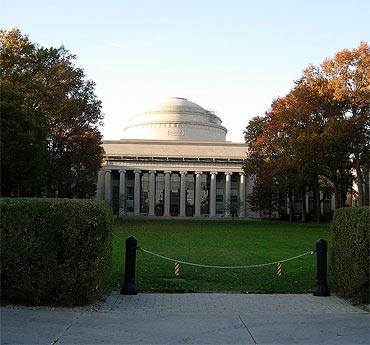
In the first part of the Study Abroad series, the author offered help about studying in Australia, followed by United Kingdom in the second part.
In the third part of the Study Abroad series, Suchitra Surve, counsellor, Global Education Counsel tells you everything you need to know about studying in the United States. Illustrations by Uttam Ghosh
Why should I study in the US?
United States of America (USA) is one of the world's leading nations in terms of technology and is certainly a nation of diverse cultures. It is not surprising that majority of aspirants are looking to study in a country that prefer the same.
It is also a great place to travel to.
The United States contains some of the most diverse beaches in the world and experiences can range from quirky amusements and raucous parties to formidable volcanoes and desolate acres of sand and shoreline, depending on where you travel.
The United States of America is a federal constitutional republic comprising fifty states and a federal district. It exercises a healthy mix of global economic, political, and military influence.
It is a permanent member of the United Nations Security Council and has a capitalist mixed economy, which is fuelled by abundant natural resources, a well-developed infrastructure, and high productivity.
The climate in USA varies across different parts of the country. Generally, the western and southern parts of US have warmer weather as compared to the eastern and northern parts. The eastern/northern parts of US experience harsh winters with heavy snowfall but the summers are pleasant. The western/southern part has extremely hot summers and comparatively tolerable winters.
Also read: All you need to know about studying in Australia
Also read: Want to study in the UK? Read this!
For Rediff Realtime News on Study Abroad, Click Here

The USA system of education is renowned for its flexibility, diversity and commitment to excellence -- amongst the best in the world. There are many public and private Universities in the USA offering variety of courses for students.
USA offers a choice of more than 3000 Universities and colleges for prospective students. There are many types of colleges and Universities in USA, and several different ways in which Americans identify them.
Broadly, American Universities confer Bachelor, Master and Doctorate degrees. Some colleges also offer Associate degrees or specialise in vocational/technical training.
The Bachelor's degree (after class 12) typically takes four years to complete. Graduate study involves study for a Master's degree. If a student has been offered an admission to more than one University then he/she has to decide which one he/she wants to attend.
How to identify the right University?
The selection of the University can be done on various factors such as best programme curriculum, choice of courses, best funding offer, and best programme with respect to costs, cost of living, and ranking of university, location or region, safety of neighbourhood, climate, social life, facilities available, accommodation & housing.
What is the right time to apply?Normally there are two major academic sessions i.e. fall intakes which happen between August to September or spring intakes i.e. January to March.
Generally, the application procedure is online, wherein students fill up the form online and submit it along with the required scores; documents are submitted well before the deadline. Universities usually inform students of their admission decisions well in advance of the beginning term.
Undergraduate Programmes (BS, BE, BA etc)
Most colleges all over the US require a minimum of 12 years of formal education. In the Indian context, it implies qualifying in class 12 examination or junior college, as applicable.
Graduate Programmes (MS, MA, MBA etc)
Almost all US universities require 16 years of undergraduate education (typically in an Indian management, undergraduate studies is for 15 years).
If a student has completed a three year degree program in India, the advisable plan of action is to maximise eligibility for US Business Schools by applying for a post graduate degree here in India.
A one-year university affiliated program will make up for the fourth year required. Some universities accept fifteen years of education as well. You may want to do your homework to find out the educational requirements of your intended college of study.
Students who apply to the US are also required to take standardised tests like GRE/ GMAT/ SAT and TOEFL etc. depending on the course or programme chosen. You must check the University website to find out which of these tests are mandatory for the programme you wish to pursue.
Also read: All you need to know to crack the new GRE
Also read: Useful tips to crack GMAT
Also read: All you need to know about the SAT exam

Approximately the tuition fees per year for undergraduate student will be in the range of $15,000 to $25,000 and for Master level programmes, the tuition fees per year will be in the range of $20,000 to $40,000. Tuition fees may vary with University and the course of study.
Students should also keep in mind the daily expenses and housing which approximately works to $4000 to $9000. The cost of living can vary as per the student's lifestyle and the options available to them
Scholarships
Scholarships are gift funds that are awarded to students based on academic merit, special talents, interests or qualities, financial need or other criteria defined by the sponsoring organisation or donor..
Tuition Waiver
This means that the student does not have to pay the tuition fees at the university.
Scholarship / Fellowship
This is usually an outright grant based on the student's academic ability and performance. Hence, only a truly outstanding A student may be considered for this type of award, before enrolling at the university.
Assistantship
Most students who receive assistance usually do so in the form of an assistantship, i.e. a cash stipend sufficient for their living expenses, and/or tuition waiver. This work normally consists of teaching and research activities.

Most of the educational institutions in USA will assist students in finding accommodation while studying in USA. Accommodations are of two types i.e. a student can stay on campus (halls of residence / student hostel) or, off campus (paying guest, apartments/ flats).
Sometimes, staying off campus turns out to be much cheaper than staying on campus.
On Campus options
Many Universities offer on-campus accommodation to International students. Dormitories are buildings with many rooms for sleeping and living, often with two or three people (of the same gender) per room. The residents of dormitories are required to share large bathrooms. It is always advisable that the student stays on campus for the first six months, for both academic and social activities. Also, it helps to cut down the travel expenses.
US colleges and universities offer very flexible meal-plan programmes, where students can choose to pay in advance for breakfast, lunch and dinner.
On most campuses, you may also deposit a certain amount of money at the beginning of the semester for food that you may buy from designated places.
Off campus options
For Universities which do not provide on-campus accommodation to international students, off-campus housing is the next best option.
The off-campus housing office assists students in finding an appropriate place to live, including information about the local neighborhood, including popular restaurants, shopping areas, parks and recreation, and public transportation.
Students can also ask their friends on campus to help out with this process or students can even contact a real estate agent. Though, beware of unspecified fees for the service.
Students study cum stay in US will be a great experience and will be able to share their knowledge with best brains, since scholars from all part of the world come here for study or work giving you an edge over others in real life.
